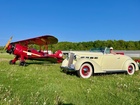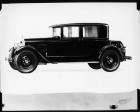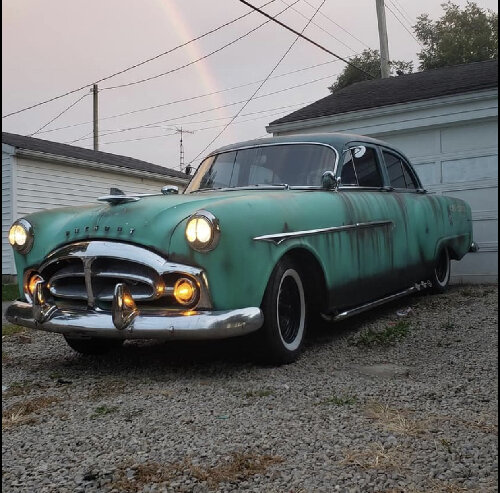|
Re: Motor suddenly dying
|
||||
|---|---|---|---|---|
|
Home away from home
|
It's possible the electric fuel pump or related wiring failed.
(Fuse?) If the electric fuel pump is pushing fuel through the stock fuel pump, be sure that the diaphragm in the stock fuel pump has not ruptured, allowing fuel to flow into the crankcase instead of into the carburetor. I would make sure that no fuel is reaching the crankcase, then determine if the ignition system is working or not. If you have ignition, it's almost certainly a fuel system issue. A timing chain issue is not out of the question, but unlikely. Don't overlook the obvious, such as a broken wire at the coil, the ignition resistor, if present, or some other minor malfunction.
Posted on: 2023/4/28 8:03
|
|||
|
||||
|
Re: White wall product inquiry
|
||||
|---|---|---|---|---|
|
Home away from home
|
"
Nitrogen diffuses more slowly through the tire than air" Assumimg that oxygen in the air contributes to yellowing, reducing oxygen permeation of the tire might be expected to retard yellowing.
Posted on: 2023/4/27 15:11
|
|||
|
||||
|
Re: White wall product inquiry
|
||||
|---|---|---|---|---|
|
Home away from home
|
Inflating tires with nitrogen rather than air might help prevent yellowing. It won't hurt anything, and is supposed to give more stable tire pressure with less variation due to temperature changes.
Posted on: 2023/4/27 12:10
|
|||
|
||||
|
Re: BigKev's 1937 115-C Convertible Coupe
|
||||
|---|---|---|---|---|
|
Home away from home
|
Putting a .01 mfd /400 V paper capacitor between the sending unit terminal and a good ground may help with the wobbling gauge. I've seen capacitors on some fuel gauge senders. I'm not sure whether they're to stabilize the gage reading or to filter radio interference, or maybe both.
Posted on: 2023/4/27 7:50
|
|||
|
||||
|
Re: White wall product inquiry
|
||||
|---|---|---|---|---|
|
Home away from home
|
Sunlight has a yellowing effect on many materials. Protecting tires from sunlight exposure may help prevent yellowing. Tires exude a waxlike material over time and this can discolor both black and white rubber and trap road film and make tires look shabby. The film is rather hard to remove, and removing it may accelerate tire decay. Removing the film and coating the cleaned surface with some material might be helpful. Some whitewalls seem to yellow from within. I doubt if those could be cleaned effectively.
Posted on: 2023/4/27 7:24
|
|||
|
||||
|
Re: BigKev's 1937 115-C Convertible Coupe
|
||||
|---|---|---|---|---|
|
Home away from home
|
It seems (per the diagram) that the gauge reading defaults to "Full" if there is an open between the dash unit and the tank unit. (Or anywhere else in the circuit)
If you're certain power is reaching the gauge from the ignition switch, I'd look for a poor connection or an intermittent tank to chassis ground. Another possibility is that the tank unit itself is not grounded to the tank. Adding a ground wire from the tank unit to the chassis might fix the problem. If the resistance element in the tank unit is broken or corroded, or if the moving contact brush is worn or corroded, it could make the gauge erratic. The gauge operates at very low current and voltage, and any poor connection anywhere in the loop will cause erratic action or no reading at all.
Posted on: 2023/4/26 20:55
|
|||
|
||||
|
Re: High Speed Rear End for 1941 Packard 110 club coupe?
|
||||
|---|---|---|---|---|
|
Home away from home
|
Determine exactly which axle ratio your car presently has.
Knowing that, you can decide which of several solutions you can choose from.
Posted on: 2023/4/26 11:36
|
|||
|
||||
|
Re: High Speed Rear End for 1941 Packard 110 club coupe?
|
||||
|---|---|---|---|---|
|
Home away from home
|
A Packard 110 ought to go about 16 to 17 MPG at 50-55 MPH. A 120 would do about the same.
The bigger cars would use more fuel. Any car I've ever owned gets poor MPG in traffic and at higher road speeds. Short trips eat gas. Higher compression would benefit fuel economy. Careful driving will make a difference.
Posted on: 2023/4/25 10:31
|
|||
|
||||
|
Re: High Speed Rear End for 1941 Packard 110 club coupe?
|
||||
|---|---|---|---|---|
|
Home away from home
|
"The tire size is 205/75/R15."
This may be part of your problem. A smaller diameter tire will cause the car to move slower at any given engine speed in high gear. A typical 205 75 R 15 passenger car tire will have a nominal diameter of 27". A tire similar to what came on your car would be a 6.50 X 16 bias ply with a diameter of around 29.5". A 7.00 X 16 tire of similar construction would have a diameter of about 31". The larger diameter tire will roll farther with each turn of the rear wheels, allowing the car to go faster at any given engine speed. I'm pretty sure your car came with 16" wheels. If it did originally have 15" wheels, the same math applies. A 7.10 X 15 tire of the correct type for a 1941 Packard would have a diameter around 30". I suggest finding out exactly what wheel size your car originally was equipped with, and what tire sizes were standard. Detailed information relating to original equipment is available on this website in the Literature Archive. Your car will ride and handle very well with original-type and size tires, and if your car has the standard axle ratio, you may find that you don't need to make any changes other than installing correct-size wheels and tires. That said, the overdrive is a wonderful adjunct to any car, and is especially nice to have on pre-WWII cars. If I owned your car, I'd want the correct wheels, tires AND the overdrive.
Posted on: 2023/4/25 10:25
|
|||
|
||||








